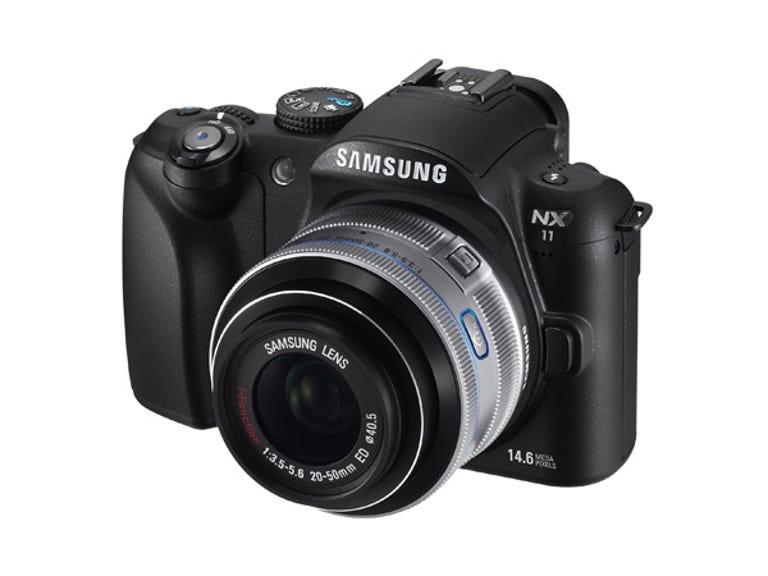 Why You Can Trust CNET
Why You Can Trust CNET Samsung NX11 review: Samsung NX11
The NX11 seems like a bit of a pointless upgrade. Without adding any new or class-changing features to an already decent camera, the NX11 can't really hold its own compared to newer offerings in the ILC market.
Interchangeable lens cameras (ILCs) are the sleeper hit of the season, with manufacturers crawling over each other to announce newer models as the days go by. Samsung's NX11 is the upgrade to the NX10 that was released in 2010. While not a huge overhaul, it offers a few incremental updates.
The Good
The Bad
The Bottom Line
Design and features
The NX system does away with the traditional mirror and pentaprism arrangement found in conventional SLR cameras, while still allowing for lenses to be interchanged in the conventional style. From the outside the NX11 looks like a shrunken-down SLR. At the top, alongside the hotshoe and pop-up flash unit is a mode dial (full PASM control, plus automatic, scene, movie, portrait and landscape auto modes). The shutter button is enclosed by the power switch, in a similar arrangement to Nikon dSLRs.
The conventional layout continues down the back until the 3-inch AMOLED screen is unveiled. Unlike the traditional LCD panels on dSLRs and Micro Four Thirds cameras, this screen uses less power and has a vivid and crisp appearance with 920,000 dots packed inside. In other words, it's a high resolution screen that's easy to see and focus with.
Other specifications include the 14.6-megapixel APS-C-sized CMOS sensor, which is the same size found in consumer digital SLRs, plus an electronic viewfinder built-in to the faux prism hump at the top of the camera. Compatible with SD/SDHC cards and using a rechargeable Lithium-ion battery, the camera also comes with HD video recording (720p).
The NX10 features image stabilisation in the lens rather than in the body, unlike one of its interchangeable lens competitors (ILC) such as the Olympus E-PL2. HDMI output is provided on the side, as well as a remote jack, AV out and external power input. The NX11 can shoot in 1:1, 3:2 or 16:9 aspect ratios.
NX10 vs. NX11
So what are the main differences between this camera and the NX10? There's only a few, which come down to a slightly different grip, compatibility with i-Function lenses and a new panorama mode on the dial. While early reports claimed that the NX11 had an upper ISO limit of 6400 like the NX100, this is not true. The NX11 caps out at ISO 3200.
The i-Function denotes the new NX system lenses with a small iFn button on the lens barrel. When pressed, this toggles between exposure adjustment, ISO, white balance and aperture/shutter by moving the focusing wheel. This works exactly the same as it did on the NX100.
Performance
The NX11 has a variety of continuous shooting modes, including standard continuous and burst that can capture at 10, 15 or 30fps (reducing the resolution to 1.4 megapixels). Samsung rates the battery at 400 shots.
Image quality
Like its companion cameras the NX100 and NX10, the NX11 produces very nice JPEG images at full resolution, with clear detail and punchy, though not over-saturated colours. The AMOLED screen makes reviewing and composing images a pleasurable experience, more so than using the electronic viewfinder, which is rather small and has a lower refresh rate.
Exposures and white balance is accurate, though the NX11 has a very slight tendency to overexpose and blow out highlights. There is some rather dramatic distortion on images taken at the wide-end of the 18-55mm kit lens. Again, like the NX10, there was some aggressive noise reduction noticeable on high ISO images.
For a further and more in-depth discussion of image quality, please consult our review of the NX10 as the sensor and image processor is unchanged.
Video quality is just as poor as it was on the NX10, with no full manual control (just program or aperture priority) or an instant record button.
Image samples
Exposure: 1/40, f/3.8, ISO 100 | Exposure: 1/50, f/4.5, ISO 250 |
Exposure: 1/40, f/4, ISO 100 | Exposure: 1/90, f/5.6, ISO 400 |
Conclusion
The NX11 seems like a bit of a pointless upgrade. Without adding any new or class-changing features to an already decent camera, the NX11 can't really hold its own compared to newer offerings from Panasonic and Olympus in the ILC market. We suggest buying an NX10 and flashing the firmware to get the support for i-Function lenses and panorama mode rather than forking out more for the NX11.
The NX11 will be available in a kit with an 18-55mm i-Function lens, 20mm pancake or 20-50mm silver lens.
Editor's note: given the similarities between this camera and the NX10, portions of this review are the same.


